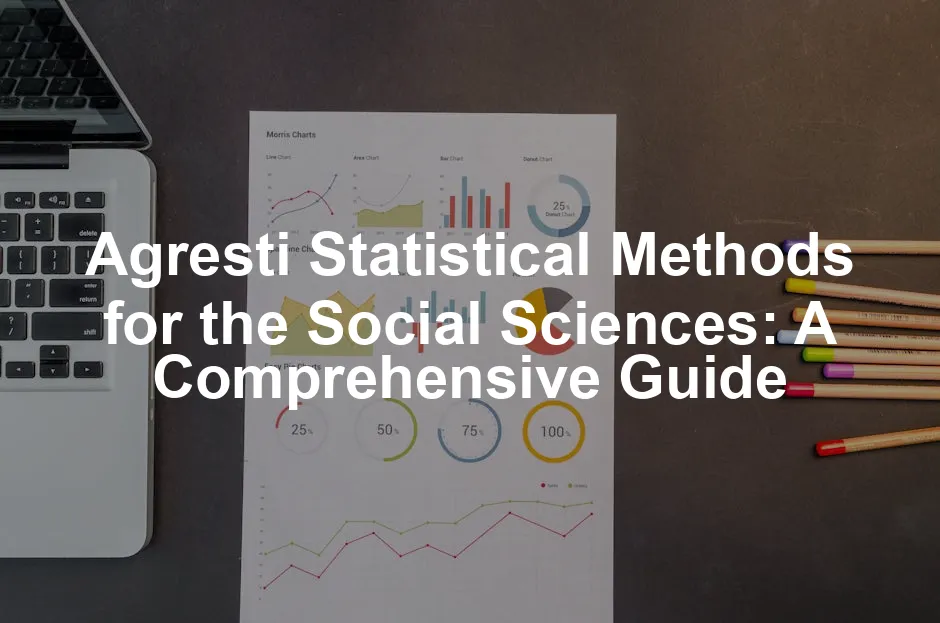Introduction
Statistics is the backbone of social sciences. It helps us make sense of human behavior and societal trends. Without robust statistical methods, researchers would be like a ship lost at sea—directionless and adrift. Alan Agresti recognized this need and stepped up to the plate. His book, Statistical Methods for the Social Sciences, offers a treasure trove of insights tailored for students and professionals alike.
Agresti’s work stands out for its clarity and accessibility. He bridges the gap between complex statistical theories and practical applications. His goal? To make statistics approachable for everyone, even those with minimal mathematical backgrounds. In this book, he walks readers through fundamental concepts, ensuring they grasp the essentials while having fun along the way.
This article will provide a comprehensive overview of Agresti’s contributions and the critical role of statistics in social sciences. We’ll break down key statistical methods, explore their applications, and reveal how his teachings can empower your research. So, buckle up! You’re in for an enlightening ride through the statistical landscape.

1. Understanding Statistical Methods
1.1 What Are Statistical Methods?
Statistical methods are systematic approaches used to collect, analyze, and interpret data. Think of them as the GPS for researchers, guiding them through the sometimes murky waters of data analysis. In social science research, these methods are essential for drawing meaningful conclusions.
We can categorize statistical methods into three main branches: descriptive, inferential, and multivariate statistics. Descriptive statistics summarize data, providing a way to visualize and understand trends. Inferential statistics help us make predictions and generalizations about a population based on a sample. Finally, multivariate statistics dive deeper, analyzing relationships between multiple variables simultaneously. Each branch plays a unique role in enabling researchers to paint a complete picture of social phenomena.
1.2 Importance of Statistics in Social Sciences
Why is statistical analysis critical in social sciences? Simply put, it transforms raw data into actionable insights. Without analysis, data is just numbers on a page—potentially useful but utterly meaningless. Statistics helps researchers understand complex social dynamics and inform decision-making.
Consider public policy. Statistical methods allow policymakers to evaluate the effectiveness of programs. They can analyze survey data to gauge public opinion on critical issues, such as healthcare or education. In sociology, researchers use statistics to identify trends in societal behavior, such as shifts in family structures or employment patterns. These real-world applications showcase the undeniable power of statistics in shaping our understanding of society.
In essence, statistical methods are not just tools for mathematicians—they are vital instruments for social scientists, enabling them to decode the complexities of human interactions and societal trends.

2. Overview of Agresti’s Book
2.1 About the Author
Alan Agresti is a rock star in the world of statistics! A Distinguished Professor in the Department of Statistics at the University of Florida, he brings over 30 years of experience teaching eager minds the intricacies of statistical analysis. With more than 100 refereed articles and several influential textbooks under his belt, Agresti’s contributions to statistics are nothing short of impressive.
His work has significantly shaped statistical education, making complex concepts accessible to students with minimal math backgrounds. Agresti has developed numerous courses tailored specifically for social science students, bridging the gap between theory and real-world application. His recognition as “Statistician of the Year” by the Chicago chapter of the American Statistical Association in 2003 speaks volumes about his impact. Beyond academia, he’s taught in about 20 countries and earned accolades for his engaging teaching style and dedication to fostering statistical literacy.
2.2 Book Structure and Content
Agresti’s Statistical Methods for the Social Sciences is a treasure trove for anyone eager to master statistics. The book is designed thoughtfully, ensuring that even those with a minimal mathematical background can grasp essential concepts.
In the 5th Edition, published in 2018, readers encounter a plethora of key topics. It begins with an introduction to statistical methodology, laying a solid foundation. Subsequent chapters cover descriptive statistics, probability distributions, and inferential statistics, including estimation and significance testing. Real data examples and exercises pepper the text, bringing theory to life.
The 6th Edition, released in 2024, builds upon its predecessor, introducing new features. It includes enhanced illustrations of statistical software, making computations less daunting. Furthermore, applets are integrated to clarify fundamental concepts like sampling distributions and basic data analyses. This edition emphasizes reducing mathematical complexities, ensuring students focus on understanding statistical methods without getting lost in formulas. For more on this, refer to the 6th Edition Testbank.
Both editions are structured to facilitate a two-semester course, making them perfect for classroom settings. The clear organization and engaging examples encourage practical learning, empowering students to apply statistical techniques confidently in their research and professional endeavors.
In a nutshell, Agresti’s book is a go-to resource, blending a friendly approach with rigorous content, making statistics not just manageable but enjoyable. Whether you’re a social science major or a curious learner, this book is bound to make you a statistics aficionado!

3.2.2 Hypothesis Testing
Hypothesis testing is a crucial aspect of statistical analysis, especially in the social sciences. It helps researchers evaluate claims about populations based on sample data. At the heart of this process are significance tests and p-values, which provide a framework for decision-making.
A significance test examines whether the evidence from a sample is strong enough to reject a null hypothesis. The null hypothesis usually posits no effect or no difference, while the alternative hypothesis indicates otherwise. P-values play a starring role here. They measure the probability of obtaining the observed data, or something more extreme, if the null hypothesis is true. A low p-value (typically below 0.05) suggests that the observed effect is statistically significant, prompting researchers to consider rejecting the null hypothesis. For a deeper understanding of hypothesis testing, check out the Statistics Hypothesis Testing Cheat Sheet.
Agresti’s book covers several common tests vital for hypothesis testing. These include t-tests, which compare means between two groups, and Chi-square tests, which assess relationships between categorical variables. The t-test is particularly useful when evaluating differences in means, such as comparing test scores between two classes. Meanwhile, the Chi-square test can reveal whether there is a significant association between variables, like gender and voting preferences.

These tests are not just theoretical; they have practical applications in real-world scenarios. For instance, a social scientist might use a t-test to determine if a new teaching method improves student performance. Or, they could employ a Chi-square test to analyze survey data for trends in public opinion.
In summary, hypothesis testing is a fundamental tool in the statistical toolbox. It empowers researchers to make informed decisions based on data, guiding them through the complexities of social science research with clarity and precision.

3.3 Regression Analysis
3.3.1 Linear Regression
Linear regression is a statistical technique that examines the relationship between two or more variables. It helps researchers ascertain how well one variable predicts another. In social sciences, linear regression can illuminate the connections between factors like education and income, or hours studied and exam scores. If you’re looking to dive deeper into regression analysis, consider picking up Practical Regression and Anova using R. It’s a fantastic resource that walks you through the intricacies of regression analysis with practical examples.
The core idea behind linear regression is to model a linear relationship. This means that changes in one variable are associated with changes in another in a predictable manner. The simplest form is the bivariate linear regression, which involves one independent variable predicting one dependent variable. The outcome is a regression equation that researchers can use to make predictions.
Understanding linear regression is crucial for predicting social behaviors. For instance, if researchers find that increased social media use correlates with lower academic performance, they can use regression analysis to estimate how changes in social media habits might affect grades.
3.3.2 Logistic Regression
Logistic regression is another powerful tool, particularly for analyzing categorical outcomes. Unlike linear regression, which focuses on continuous data, logistic regression predicts the probability of a binary outcome—think yes/no or success/failure scenarios. This makes it invaluable in social science research when examining phenomena like voting behavior or the likelihood of participating in a community program.
For example, researchers might analyze survey data to determine the factors influencing voter turnout. They could use logistic regression to assess how variables such as age, education level, and income affect the probability of someone voting. To get a solid grounding in logistic regression, check out Data Science for Business. It provides insights into how data science techniques can be applied in practical scenarios.
Real-world applications abound. In public health, logistic regression can help analyze the likelihood of individuals engaging in risky behaviors based on demographic factors. In marketing, companies might use this technique to predict whether potential customers will buy a product based on their characteristics.

In summary, regression analysis—both linear and logistic—provides essential insights into social behaviors and outcomes. By employing these methods, researchers can uncover relationships between variables and make informed predictions that drive meaningful action.
4.2 Nonparametric Methods
Nonparametric statistics are like the cool kids of the statistical world. They don’t require the data to follow any specific distribution, making them super flexible. When researchers face small sample sizes or data that doesn’t meet the assumptions of parametric tests, nonparametric methods come to the rescue. Think of them as the Swiss Army knife of statistics—ready for any situation!
Agresti’s book highlights several nonparametric methods, such as the Wilcoxon rank-sum test and the Kruskal-Wallis test. The Wilcoxon rank-sum test is ideal for comparing two independent groups when the data isn’t normally distributed. Meanwhile, the Kruskal-Wallis test allows researchers to compare more than two groups. These methods provide robust alternatives to their parametric counterparts, ensuring researchers can draw meaningful conclusions from their data without the pressure of meeting strict assumptions.

4.3 Use of Statistical Software
In today’s data-driven world, statistical software is as essential as coffee for a late-night study session. Agresti’s book mentions several powerful tools: R, SPSS, and SAS. Each software package has its unique features, catering to different user needs. If you’re just starting, you might want to explore SPSS Statistics for Dummies. It’s a great introduction for those who prefer a more visual approach to data analysis.
R is open-source and boasts an extensive library of packages for every statistical method imaginable. It’s like a buffet for data enthusiasts! SPSS, on the other hand, is user-friendly, making it a favorite for those who prefer a graphical interface. It’s perfect for social scientists who want to focus on results rather than coding. Lastly, SAS is a commercial powerhouse known for its advanced analytics capabilities, making it ideal for larger datasets and complex analyses. For troubleshooting SPSS, you might find the SPSS Statistics Fix useful.
Using software is crucial in modern statistical analysis. It not only streamlines calculations but also enhances accuracy. With the ability to visualize data and automate processes, researchers can focus on what really matters—drawing insights and making impactful decisions.

FAQs
Please let us know what you think about our content by leaving a comment down below!
Thank you for reading till here 🙂
If you’re looking for a deeper dive into data analysis, consider checking out The Elements of Statistical Learning. This book is a fantastic resource for anyone looking to deepen their understanding of statistical modeling and machine learning.
For those interested in a lighter read, Naked Statistics: Stripping the Dread from the Data is a great choice. It presents statistical concepts in an engaging and humorous way, making it perfect for those who might find traditional textbooks daunting.
If you want to explore data visualization techniques, look no further than Data Visualization: A Practical Introduction. This book serves as a comprehensive guide to creating effective data visualizations, which can be a game-changer in presenting your findings.
All images from Pexels




